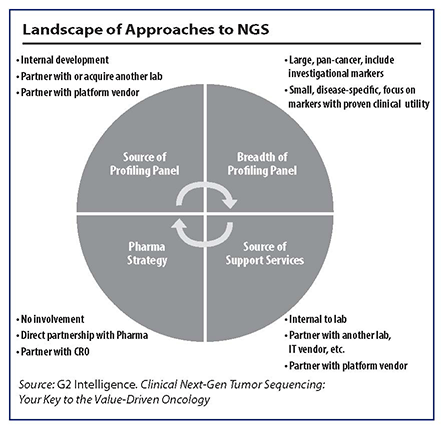In the coming three to five years, more than half of U.S. CLIA laboratories that perform tumor testing will begin to offer next-generation sequencing (NGS)-based services, according to G2’s recently released report
Clinical Next-Gen Tumor Sequencing: Your Key to the Value-Driven Oncology Market.
The report, based on qualitative interviews with NGS stakeholders, including hospital and independent laboratories as well as sequencing platform and service vendors, assesses the current state and anticipated evolution of NGS within oncological practice, the current leading clinical area of NGS testing.
While the industry marvels at the speed with which the cost of sequencing has plummeted, NGS has for all practical purposes not truly reached the awaited $1,000 per genome threshold. Yet adoption of NGS-based testing is permeating clinical care at a pace unlike any other technology seen in the modern era of laboratory medicine. Clinical NGS testing is currently available for evaluation
of somatic mutations in both solid tumors (lung, breast, prostate, or colon) and liquid malignicies (lymphomas, leukemias), although the report finds that the most rapid adoption of NGS testing has been seen in lung cancer care, largely because of the availability of targeted therapies. Only a fraction of the NGS market is for hereditary cancer targeting germline mutations.
Early NGS adopters include academic medical center laboratories, large reference laboratories, and specialty laboratories. However, adoption of NGS testing by smaller labs is anticipated in the coming years, driven by community-based oncologists. For labs that are early adopters, the report finds that there are three dominant market opportunities: partnering with pharmaceutical companies or contract research organizations in support of clinical trials or biomarker development, direct commercial clinical testing, and commercializing and licensing NGS panels or support services (bioinformatics and interpretation services).
Of course to realize the market opportunities, several challenges must be overcome, including clinically meaningful interpretation of results. Downstream implications of the interpretation challenge are immature NGS guidelines and difficulty generating evidence of clinical utility, which in turn impact regulatory approval and reimbursement.
The report says that the U.S. Food and Drug Administration’s 2013 approval of Illumina’s MiSeqDx sequencing platform “may serve as a green light to laboratories looking for regulatory clarity regarding the use of NGS in clinical settings.”
As with the broader molecular diagnostics reimbursement landscape, laboratories are stymied by a lack of clear-cut policies to guide payer decisions of innovative tests. The system currently lacks appropriate coding for submitting NGS claims. As codes are developed, all NGS test providers will need to work toward establishing evidence of clinical utility of NGS tests for payers. While definitive evidence is still lacking, many hold that NGS does afford a promising value proposition as it has the potential to improve the value of oncological care by streamlining the diagnostic process, reducing wasteful spending on ineffective therapies; improving clinical outcomes; and identifying end-of-life patients best served by palliative care.
Despite the ecosystem challenges, G2 predicts “accelerated” adoption over the next five years. A sharp uptick in the number of U.S. CLIA laboratories using NGS tumor testing is expected—from 7 percent in 2013 to an anticipated majority in five years. While initial focus of NGS has been on the capabilities of the technological platforms, industry interest is burgeoning in bioinformatics service vendors. These vendors will play a pivotal role in the broader transition of NGS into clinical practice, given the limited availability of resources and talent to create proprietary interpretation algorithms, particularly in smaller, community laboratories or oncology practices.
Takeaway: NGS tumor testing is expected to proliferate in the next several years as smaller laboratories adopt the technology, driving related growth among NGS service vendors including bioinformatics and interpretation providers.
To Read the Full Report
Clinical Next-Gen Tumor Sequencing: Your Key to the Value-Driven Oncology Market is available for $1,195 from G2 Intelligence (
www.G2Intelligence.com).
Associated Data

